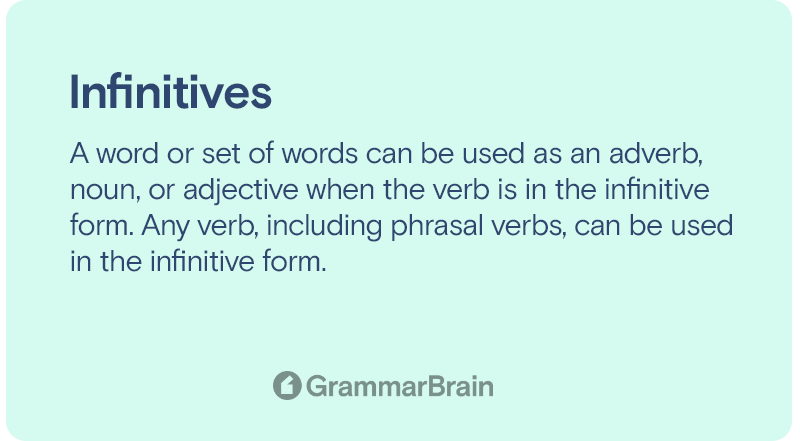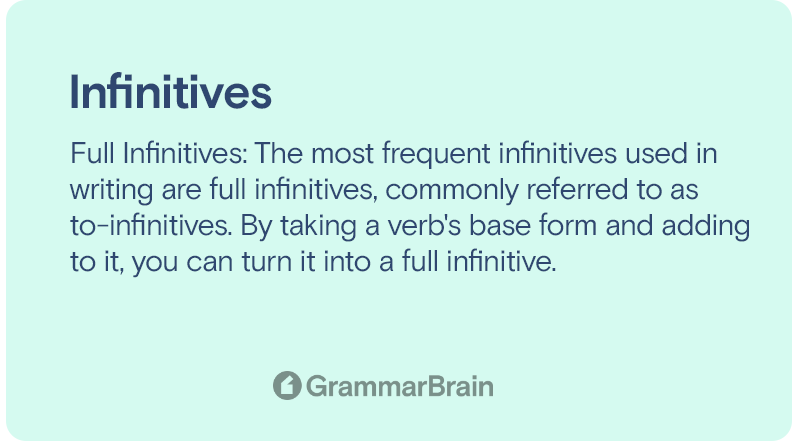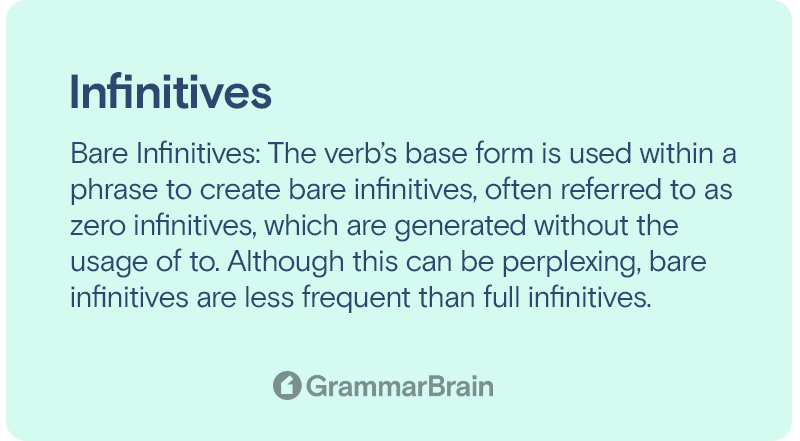The infinitive verb form can be used as an adverb, noun, or adjective. When expressing desires to do something without actually doing it, such as saying, “I want to go to school.” Or “To err is human,” they might be helpful. Usually, the term is used before the primary verb.
The infinitive form is essential to English and many other languages, yet understanding its grammatical rules can get complicated. This article provides clear infinitive examples to help grasp how they work. And provides detailed coverage of the many types of infinitives and how to utilize them.

What is the infinitive form (infinitives)?
A word or set of words can be used as an adverb, noun, or adjective when the verb is in the infinitive form. Any verb, including phrasal verbs, can be used in the infinitive form.
There are instances where the verb’s base form is used alone, even though the word to is generally added before it, as in to be.
| Verbs that use actors with infinitive phrases | Verbs that don’t use actors with infinitive phrases | Verbs that could use actors with infinitive phrases |
| advise allow appoint convince encourage force hire implore incite instruct invite order permit remind teach tell | agree begin continue decide fail hesitate hope intend learn neglect offer plan prefer pretend promise refuse remember start try | ask expect like want need |
| Infinitive: to do | Gerund: doing |
| After verbs: agree, appear, arrange, attempt | After verbs: avoid, bear, consider, deny |
| After verb+object combinations: advise, allow, ask, forbid | After prepositions: Is he still interested in dancing? |
| After adjectives: Anxious, anger, delighted | As subjects and complements: What really gets on my nerves is singing out of tune. |

What are the two types of infinitives?
Infinitives can be divided into two categories: full infinitives and bare infinitives. Below, we describe each and when to utilize them.
- Full Infinitives: The most frequent infinitives used in writing are full infinitives, commonly referred to as to-infinitives. By taking a verb’s base form and adding to it, you can turn it into a full infinitive.
- Bare Infinitives: The verb’s base form is used within a phrase to create bare infinitives, often referred to as zero infinitives, which are generated without the usage of to. Although this can be perplexing, bare infinitives are less frequent than full infinitives.
Full infinitives grammar rules:
- To show purpose or intention.
- To modify nouns.
- To get used as the subject of a sentence.
- To get used after adjectives.
- With the words “too” or “enough.”
- With phrases that contain relative pronouns.
- With certain words like “afford, agree, aim, appear, arrange, attempt, beg, care, choose, claim, consent, decided, demand, deserve, determine, endeavor, expect, fail, forget, happen)
Bare infinitives grammar rules:
- After modal verbs (can, may, might, could, should, would, will, and must).
- After perception verbs (hear, see, taste, feel).
- With verbs “let, make, and do”
- With a relative pronoun “why”
Infinitives as adjectives
Similar to how full infinitives can change the meaning of verbs by adding extra information, they can similarly change the meaning of nouns. They serve as adjectives and adjective phrases in this situation. This case is used to show intention or purpose.
For example:
- Son left to play baseball.
Infinitives as adverbs
Infinitives are frequently used in place of the words “in order to” to describe a person’s motivations. They serve as adverbs to describe the primary verb in this situation.
For example:
- Would you like anything to eat?
Infinitives as nouns
Infinitives can act as nouns in the subject or object place. In this example, ‘to sleep’ acts as a noun at the object’s place.
For example:
- The little puppy needed to sleep.
How to identify infinitives
Infinitives follow a particular structure. ‘To + VERB’ creates an infinitive phrase, which includes verbs like eat, run, walk, clothe, shout, and more. An adverb or adjective that modifies the meaning of other words in a phrase is known as a modifier.
In a sentence, try to find the word ‘to’ followed by a verb that would be the infinitive. Follow these three simple steps for that.
Example sentence: Rahul planned to leave the party quickly.
Step 1: Determine whether an infinitive phrase is present in the statement.
- In this sentence, the verb to leave is used as the infinitive: leave is a simple verb coupled with the verb ‘to.’
Step 2: Determine how the infinitive phrase behaves.
- The infinitive phrase serves as an adverb in the sentence.
Step 3: Determine what the infinitive phrase modifies.
- The word planned is modified by the infinitive phrase ‘to exit the party quickly.
How to use the infinitive form
Even though we have already discussed the primary purposes of the two infinitive forms, some infinitive grammar must be discussed. Infinitive grammar can be understood in three main ways: continuous infinitives, split infinitives, and passive infinitives.
Split infinitives
A split infinitive, such as to angrily groan, is a full infinitive with an adverb or adverbial phrase between it and the root verb.
Grammarians disagree on the issue of split infinitives; some believe they should be avoided, while others believe they are acceptable. On whether or not they are accurate, there is no official response.
Passive Infinitives
Infinitives can be written in the passive voice (passive infinitives), much like other verbs. In the passive voice, the verb’s subject receives the action rather than being the one who does it.
Both complete infinitives and bare infinitives are compatible with passive infinitives.
Continuous infinitives
Continuous infinitives indicate a continuing action, just like continuous tense verbs do. Continuous infinitives substitute the word be + the present participle for the verb’s base form (the -ing form).
Use to be doing, for instance, to turn the infinitive to do into a continuous infinitive.

FAQs
What is an infinitive phrase?
Not all infinitives must stand on their own. As several of our infinitive examples from above demonstrate, infinitives can combine with other words to create what’s known as an infinitive phrase.
Simply put, infinitive phrases alter or elaborate on the basic infinitive with other words.
For example, my grandfather asked me to watch my little brother.
How do infinitives work?
Although an infinitive’s basic form is a verb, infinitives can also be used as nouns, adjectives, or adverbs in sentences. They are useful when you wish to talk about a generic action rather than a specific instance.
What are the types of infinitives?
The two primary categories of infinitives are. Full infinitives, often referred to as to-infinitives, are the first verb form and use the term to before the basic form. The second type is bare infinitives, commonly referred to as zero infinitives, which solely use a verb’s base form without the to.
What is the purpose of infinitives?
Actions generally are described using infinitives rather than any particular action being performed. Remember that a prepositional phrase starting with to, which consists of a noun or pronoun and any modifiers, is not the same as an infinitive. Which is a verbal made up of to plus a verb.
How do you find a direct object in infinitive forms?
Special Verb + Direct Object + Infinitive
What is a split infinitive?
It is a full infinitive that contains an adverb or adverbial phrase. It is usually between the infinitive and the base verb. Certain verbs always use the full infinitive if they’re followed by a verb form.
Inside this article
Fact checked:
Content is rigorously reviewed by a team of qualified and experienced fact checkers. Fact checkers review articles for factual accuracy, relevance, and timeliness. Learn more.
Core lessons
Glossary
- Abstract Noun
- Accusative Case
- Anecdote
- Antonym
- Active Sentence
- Adverb
- Adjective
- Allegory
- Alliteration
- Adjective Clause
- Adjective Phrase
- Ampersand
- Anastrophe
- Adverbial Clause
- Appositive Phrase
- Clause
- Compound Adjective
- Complex Sentence
- Compound Words
- Compound Predicate
- Common Noun
- Comparative Adjective
- Comparative and Superlative
- Compound Noun
- Compound Subject
- Compound Sentence
- Copular Verb
- Collective Noun
- Colloquialism
- Conciseness
- Consonance
- Conditional
- Concrete Noun
- Conjunction
- Conjugation
- Conditional Sentence
- Comma Splice
- Correlative Conjunction
- Coordinating Conjunction
- Coordinate Adjective
- Cumulative Adjective
- Dative Case
- Determiner
- Declarative Sentence
- Declarative Statement
- Direct Object Pronoun
- Direct Object
- Diction
- Diphthong
- Dangling Modifier
- Demonstrative Pronoun
- Demonstrative Adjective
- Direct Characterization
- Definite Article
- Doublespeak
- False Dilemma Fallacy
- Future Perfect Progressive
- Future Simple
- Future Perfect Continuous
- Future Perfect
- First Conditional
- Irregular Adjective
- Irregular Verb
- Imperative Sentence
- Indefinite Article
- Intransitive Verb
- Introductory Phrase
- Indefinite Pronoun
- Indirect Characterization
- Interrogative Sentence
- Intensive Pronoun
- Inanimate Object
- Indefinite Tense
- Infinitive Phrase
- Interjection
- Intensifier
- Infinitive
- Indicative Mood
- Participle
- Parallelism
- Prepositional Phrase
- Past Simple Tense
- Past Continuous Tense
- Past Perfect Tense
- Past Progressive Tense
- Present Simple Tense
- Present Perfect Tense
- Personal Pronoun
- Personification
- Persuasive Writing
- Parallel Structure
- Phrasal Verb
- Predicate Adjective
- Predicate Nominative
- Phonetic Language
- Plural Noun
- Punctuation
- Punctuation Marks
- Preposition
- Preposition of Place
- Parts of Speech
- Possessive Adjective
- Possessive Determiner
- Possessive Case
- Possessive Noun
- Proper Adjective
- Proper Noun
- Present Participle
- Prefix
- Predicate



